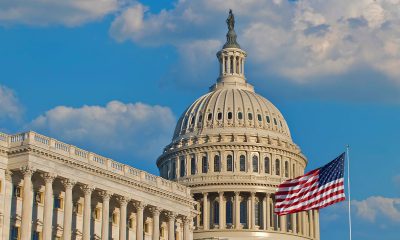Bay Area
Marin Aligns with State on Face Covering Guidelines Universal Indoor Masking Returns to All Indoor Public Spaces
Effective as of 12:01 a.m. Thursday, Dec. 30, previous local face covering exemptions carved out for indoor spaces with consistent cohorts of fully vaccinated people will no longer apply. Now, all people in Marin County, regardless of vaccination status, will be required to wear a mask in all indoor public settings, in accordance with the state-wide mandate. This includes gyms, fitness centers, office settings, employee commuter vehicles, religious gatherings, college classes, and similar settings.

Courtesy of Marin County
With COVID-19 case rates rising rapidly, Marin County Public Health is aligning with the California Department of Public Health (CDPH) and requiring the wearing of face coverings in all indoor public places to stem the virus’ spread.
Effective as of 12:01 a.m. Thursday, Dec. 30, previous local face covering exemptions carved out for indoor spaces with consistent cohorts of fully vaccinated people will no longer apply. Now, all people in Marin County, regardless of vaccination status, will be required to wear a mask in all indoor public settings, in accordance with the state-wide mandate. This includes gyms, fitness centers, office settings, employee commuter vehicles, religious gatherings, college classes, and similar settings.
The first case of Omicron variant in Marin was identified on Dec. 17. Since then, average daily COVID-19 case counts have tripled, fueled by the highly contagious Omicron variant. On Dec. 28, 338 new cases were reported, exceeding the prior highest daily case count by more than 100 cases.
“When we see numbers like this, it’s time to respond,” said Dr. Matt Willis, Marin County Public Health Officer. “The mask exemption for certain settings was a pre-Omicron policy. This variant behaves differently, and the risk of infection in a room full of vaccinated people who are unmasked is much higher now.”
Despite rising case counts, hospitalization rates for COVID-19 infections have remained stable across Marin. That is attributed to Marin County’s very high vaccination rate: 92.1% of Marin’s population ages 5 and over have completed a COVID-19 vaccine series. Still, health authorities express concern that hospitalization rates could increase significantly in the coming days if case counts continue to rise at current rates.
CDPH’s statewide indoor mask mandate went into effect Dec. 15. At that time, Marin and other local counties were given an option to adopt a pre-existing mask order in lieu of the state’s order. Marin and five other jurisdictions — the counties of Sonoma, San Francisco, Contra Costa, Alameda, and the city of Berkeley — adopted local orders that allowed some exemptions not found in the state’s policy. The recension of the local order means Marin now falls under CDPH’s mask order, which remains in effect through at least Jan. 15, 2022.
On Dec. 28, Contra Costa County made a similar announcement, issuing a new health order that removed limited exemptions to indoor mask use.
COVID-19 vaccines, including booster doses, continue to offer the most effective protection against hospitalization and death from all variants of COVID-19 circulating in the Bay Area.
Safe, free, and effective COVID-19 vaccines are available to everyone ages 5 and up. Book an appointment or find a nearby clinic on GetVaccinatedMarin.org.
More information face coverings, local policies, and resources for businesses, including printable signs, can be found at Coronavirus.MarinHHS.org/masks.
Alameda County
Seth Curry Makes Impressive Debut with the Golden State Warriors
Seth looked comfortable in his new uniform, seamlessly fitting into the Warriors’ offensive and defensive system. He finished the night with an impressive 14 points, becoming one of the team’s top scorers for the game. Seth’s points came in a variety of ways – floaters, spot-up three-pointers, mid-range jumpers, and a handful of aggressive drives that kept the Oklahoma City Thunder defense on its heels.

By Y’Anad Burrell
Tuesday night was anything but ordinary for fans in San Francisco as Seth Curry made his highly anticipated debut as a new member of the Golden State Warriors. Seth didn’t disappoint, delivering a performance that not only showcased his scoring ability but also demonstrated his added value to the team.
At 35, the 12-year NBA veteran on Monday signed a contract to play with the Warriors for the rest of the season.
Seth looked comfortable in his new uniform, seamlessly fitting into the Warriors’ offensive and defensive system. He finished the night with an impressive 14 points, becoming one of the team’s top scorers for the game. Seth’s points came in a variety of ways – floaters, spot-up three-pointers, mid-range jumpers, and a handful of aggressive drives that kept the Oklahoma City Thunder defense on its heels.
One of the most memorable moments of the evening came before Seth even scored his first points. As he checked into the game, the Chase Center erupted into applause, with fans rising to their feet to give the newest Warrior a standing ovation.
The crowd’s reaction was a testament not only to Seth’s reputation as a sharpshooter but also to the excitement he brings to the Warriors. It was clear that fans quickly embraced Seth as one of their own, eager to see what he could bring to the team’s championship aspirations.
Warriors’ superstar Steph Curry – Seth’s brother – did not play due to an injury. One could only imagine what it would be like if the Curry brothers were on the court together. Magic in the making.
Seth’s debut proved to be a turning point for the Warriors. Not only did he contribute on the scoreboard, but he also brought a sense of confidence and composure to the floor.
While their loss last night, OKC 124 – GSW 112, Seth’s impact was a game-changer and there’s more yet to come. Beyond statistics, it was clear that Seth’s presence elevated the team’s performance, giving the Warriors a new force as they look to make a deep playoff run.
Activism
Oakland Post: Week of November 26 – December 2, 2025
The printed Weekly Edition of the Oakland Post: Week of November 26 – December 2, 2025

To enlarge your view of this issue, use the slider, magnifying glass icon or full page icon in the lower right corner of the browser window.
Activism
Oakland Post: Week of November 19 – 25, 2025
The printed Weekly Edition of the Oakland Post: Week of November 19 – 25, 2025

To enlarge your view of this issue, use the slider, magnifying glass icon or full page icon in the lower right corner of the browser window.
-

 Activism3 weeks ago
Activism3 weeks agoOakland Post: Week of November 12 – 18, 2025
-

 Activism4 weeks ago
Activism4 weeks agoOakland Post: Week of November 5 – 11, 2025
-

 Activism2 weeks ago
Activism2 weeks agoIN MEMORIAM: William ‘Bill’ Patterson, 94
-

 Activism3 weeks ago
Activism3 weeks agoHow Charles R. Drew University Navigated More Than $20 Million in Fed Cuts – Still Prioritizing Students and Community Health
-

 #NNPA BlackPress3 weeks ago
#NNPA BlackPress3 weeks agoThe Perfumed Hand of Hypocrisy: Trump Hosted Former Terror Suspect While America Condemns a Muslim Mayor
-

 Bay Area3 weeks ago
Bay Area3 weeks agoNo Justice in the Justice System
-

 #NNPA BlackPress3 weeks ago
#NNPA BlackPress3 weeks agoProtecting Pedophiles: The GOP’s Warped Crusade Against Its Own Lies
-

 #NNPA BlackPress2 weeks ago
#NNPA BlackPress2 weeks agoTrump’s Death Threat Rhetoric Sends Nation into Crisis





















































